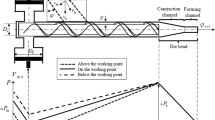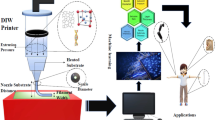Abstract
In this paper, the effect of the nip force on the ink transfer in gravure printings was investigated. An adhesive force-based ink transfer model was suggested. This model is a function of the contact length between the ink and the substrate. The static simulation of the elastic deformation of the substrate was implemented under different nip forces. The simulation showed that the contact length (LIS) was increased as the nip force increased. Accordingly, the ink transfer ratio was increased as the nip force increased due to an increased contact length LIS. However, the fidelity of the printed pattern at high resolutions could deteriorate if the nip pressure was too high, especially when the doctoring ratio was greater than 1. Finally, experiments were conducted to verify the effect of the nip force, which showed good agreements with predicted results. The results of this study may be used as practical guidelines in determining the optimal range of the nip force in R2R gravure printing at high resolutions.
Similar content being viewed by others
Abbreviations
- η T :
-
Ink transfer ratio
- η I :
-
Inking ratio
- η D :
-
Doctoring ratio
- η P :
-
Printing ratio
- V f :
-
Filled volume
- V cell :
-
Cell volume
- V r :
-
Remained volume
- V p :
-
Printed volume
- F IC :
-
adhesive force at ink-cell interface
- F IS :
-
adhesive force at ink-substrate interface
- F I :
-
cohesive force of ink
- W IC :
-
work of adhesive at ink-cell interface
- W IS :
-
work of adhesive at ink- substrate interface
- L IC :
-
contact length at ink-cell interface
- L IS :
-
contact length at ink-substrate interface
- p n (z) :
-
Distribution of the pressure
- b :
-
Footprint
- R eq :
-
Equivalent radius
- R nip :
-
Nip roller radius
- R print :
-
Printing roller radius
- w nip :
-
Printing roller width
- δ:
-
Indentation
- trub :
-
Rubber layer thickness
- νrub :
-
Rubber Poisson ratio
- E0):
-
Young’s modulus of rubber
- F N :
-
Nip force
- V before :
-
Volume of the printed pattern before drying
- V after :
-
Volume of the printed pattern after drying
- M Ag :
-
Silver mass
- M H2O :
-
Water mass
- ρ Ag :
-
Water density
- ρ H2O :
-
Water density
- wt :
-
Solid content
- w cell :
-
Cell width
- d cell :
-
Cell depth
- L cell :
-
Cell Length
- w p * :
-
Printed pattern width after drying
- t p * :
-
Printed pattern depth after drying
- L p * :
-
Printed pattern Length after drying
References
Jung, M., Kim, J., Noh, J., Lim, N., Lim, C., et al., “All-Printed and Roll-to-Roll-Printable 13.56-MHz-Operated 1-Bit RF Tag on Plastic Foils,” IEEE Transactions on Electron Devices, Vol. 57, No. 3, pp. 571–580, 2010.
Potyrailo, R. A., Burns, A., Surman, C., Lee, D., and McGinniss, E., “Multivariable Passive RFID Vapor Sensors: Roll-to-Roll Fabrication on a Flexible Substrate,” Analyst, Vol. 137, No. 12, pp. 2777–2781, 2012.
Krebs, F. C., Nielsen, T. D., Fyenbo, J., Wadstrøm, M., and Pedersen, M. S., “Manufacture, Integration and Demonstration of Polymer Solar Cells in a Lamp for the “Lighting Africa” Initiative,” Energy & Environmental Science, Vol. 3, No. 5, pp. 512–525, 2010.
Lo, C. Y., Hiitola-Keinänen, J., Huttunen, O. H., Petäjä, J., Hast, J., et al., “Novel Roll-to-Roll Lift-off Patterned Active-Matrix Display on Flexible Polymer Substrate,” Microelectronic Engineering, Vol. 86, No. 4, pp. 979–983, 2009.
Chen, J., Cranton, W., and Fihn, M., “Handbook of Visual Display Technology,” Springer, pp. 32–42, 2012.
Kim, K., Kim, C. H., Kim, H. Y., and Kim, D. S., “Effects of Blanket Roller Deformation on Printing Qualities in Gravure-Offset Printing Method,” Japanese Journal of Applied Physics, Vol. 49, No. 5S1, Paper No. 05EC04, 2010.
Bould, D., Claypole, T., and Bohan, M., “An Investigation into Plate Deformation in Flexographic Printing,” Proceedings of the Institution of Mechanical Engineers, Part B: Journal of Engineering Manufacture, Vol. 218, No. 11, pp. 1499–1511, 2004.
Kang, H., Kitsomboonloha, R., Jang, J., and Subramanian, V., “High-Performance Printed Transistors Realized using Femtoliter Gravure-Printed Sub-10 μm Metallic Nanoparticle Patterns and highly Uniform Polymer Dielectric and Semiconductor Layers,” Advanced Materials, Vol. 24, No. 22, pp. 3065–3069, 2012.
Kitsomboonloha, R., Morris, S., Rong, X., and Subramanian, V., “Femtoliter-Scale Patterning by High-Speed, highly Scaled Inverse Gravure Printing,” Langmuir, Vol. 28, No. 48, pp. 16711–16723, 2012.
Noh, J., Yeom, D., Lim, C., Cha, H., Han, J., et al., “Scalability of Roll-to-Roll Gravure-Printed Electrodes on Plastic Foils,” IEEE Transactions on Electronics Packaging Manufacturing, Vol. 33, No. 4, pp. 275–283, 2010.
Sung, D., de la Fuente Vornbrock, A., and Subramanian, V., “Scaling and Optimization of Gravure-Printed Silver Nanoparticle Lines for Printed Electronics,” IEEE Transactions on Components and Packaging Technologies, Vol. 33, No. 1, pp. 105–114, 2010.
Nguyen, H. A. D., Lee, J., Kim, C. H., Shin, K. H., and Lee, D., “An Approach for Controlling Printed Line-Width in High Resolution Roll-to-Roll Gravure Printing,” Journal of Micromechanics and Microengineering, Vol. 23, No. 9, Paper No. 095010, 2013.
Nguyen, H. A. D., Shin, K. and Lee, D., “Effect of Process Parameters on fidelity of Printed Line Width in High Resolution Roll-to-Roll Gravure Printing,” Japanese Journal of Applied Physics, Vol. 53, No. 5S3, Paper No. 05HC04, 2014.
Nguyen, H. A. D., Lee, C., and Shin, K.-H., “A Mathematical Model to Predict Surface Roughness and Pattern Thickness in Roll-to-Roll Gravure Printed Electronics,” Robotics and Computer-Integrated Manufacturing, Vol. 29, No. 4, pp. 26–32, 2013.
Lee, C., Kang, H., Kim, C., and Shin, K., “A Novel Method to Guarantee the Specified Thickness and Surface Roughness of the Roll-to-Roll Printed Patterns using the Tension of a Moving Substrate,” Journal of Microelectromechanical Systems, Vol. 19, No. 5, pp. 1243–1253, 2010.
Jiang, W., Liu, H., Ding, Y., Shi, Y., Yin, L., and Lu, B., “Investigation of Pattern Coating on Mould Roller in Roller-Reversal Imprint Process,” Microelectronic Engineering, Vol. 86, No. 12, pp. 2412–2416, 2009.
Deshmukh, R. R. and Bhat, N. V., “The Mechanism of Adhesion and Printability of Plasma Processed Pet Films,” Materials Research Innovations, Vol. 7, No. 5, pp. 283–290, 2003.
Sankaran, A. K. and Rothstein, J. P., “Effect of Viscoelasticity on Liquid Transfer during Gravure Printing,” Journal of Non-Newtonian Fluid Mechanics, Vols. 175–176, pp. 64–75, 2012.
Seo, S. M., Park, J. Y., and Lee, H. H., “Micropatterning of Metal Substrate by Adhesive Force Lithography,” Applied Physics Letters, Vol. 86, No. 13, Paper No. 133114, 2005.
Iizuka, Y. and Yamaura, H., “Analysis of Flexible Media Transport Characteristics of Crown Roller and Its Application to Design (Machine Elements and Manufacturing) [in Japanese],” Transactions of the Japan Society of Mechanical Engineers. C, Vol. 75, No. 754, pp. 1851–1858, 2009.
Johnson, K. L. and Johnson, K. L., “Contact Mechanics,” Cambridge University Press, pp. 102–118, 1985.
Good, J. K., “Modeling Rubber Covered Nip Rollers in Web Lines,” Proc. of the Sixth International Conference on Web Handling, pp. 159–180, 2001.
Bhushan, B., “Mechanics and Reliability of Flexible Magnetic Media,” Springer, pp. 20–45, 2000.
Kosmala, A., Zhang, Q., Wright, R., and Kirby, P., “Development of High Concentrated Aqueous Silver Nanofluid and Inkjet Printing on Ceramic Substrates,” Materials Chemistry and Physics, Vol. 132, No. 2, pp. 788–795, 2012.
Author information
Authors and Affiliations
Corresponding author
Rights and permissions
About this article
Cite this article
Nguyen, H.A.D., Shin, K. & Lee, C. Effect of nip force on ink transfer in high resolution roll-to-roll printing. Int. J. Precis. Eng. Manuf. 16, 517–523 (2015). https://doi.org/10.1007/s12541-015-0070-9
Received:
Revised:
Accepted:
Published:
Issue Date:
DOI: https://doi.org/10.1007/s12541-015-0070-9




